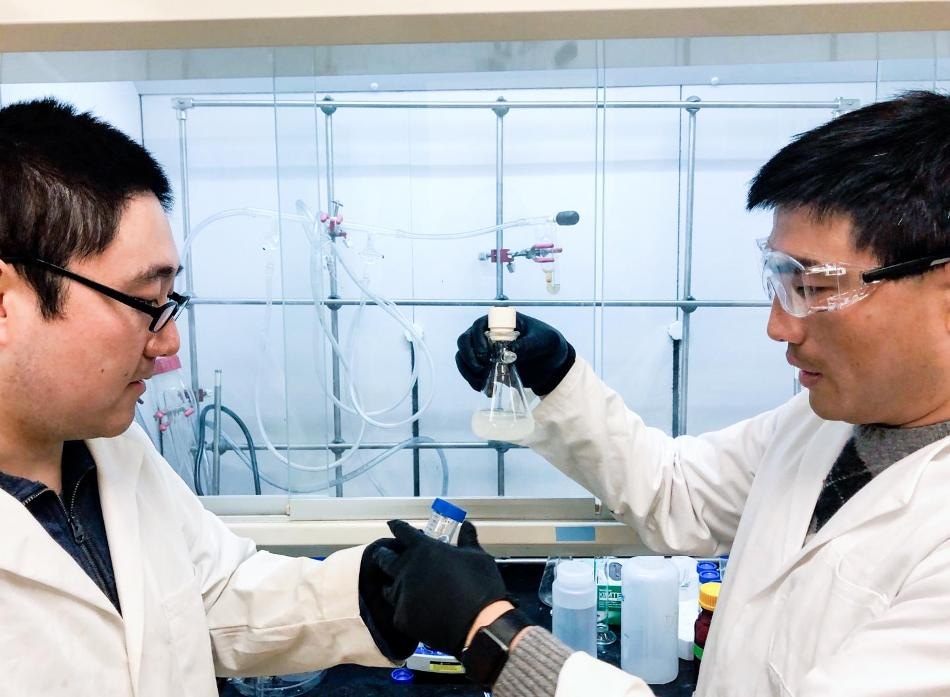Mar 15 2019
Access to clean water is one of the major challenges being faced globally. A research team from The University of Texas at Austin has achieved a breakthrough in finding a novel solution to this issue using solar-powered technology that converts moisture absorbed from the atmosphere into clean, usable water.
 Fei Zhao (L), coauthor of the study, and Guihua Yu (R) of Yu Research Labs at UT Austin examining a sample of their newly developed hydrogel. (Image credit: Cockrell School of Engineering, The University of Texas at Austin)
Fei Zhao (L), coauthor of the study, and Guihua Yu (R) of Yu Research Labs at UT Austin examining a sample of their newly developed hydrogel. (Image credit: Cockrell School of Engineering, The University of Texas at Austin)
The technology, reported in the latest issue of Advanced Materials, can possibly be used in water crises, catastrophes, or poverty-affected areas and developing countries. This technology depends on hydrogels, which are gel–polymer hybrid materials that are designed as “super sponges” to retain more water.
The team of researchers led by Guihua Yu in UT Austin’s Cockrell School of Engineering has synthesized hydrogels that are capable of absorbing more water and releasing the same when heated. This remarkable combination has been successfully demonstrated to work in dry and humid weather conditions and significantly helps in the production of clean, safe drinking water from the atmosphere.
With about 50,000 km3 of water present in the atmosphere, this novel system could tap into those supplies and possibly lead to the development of small, cheap, and portable filtration systems.
We have developed a completely passive system where all you need to do is leave the hydrogel outside and it will collect water. The collected water will remain stored in the hydrogel until you expose it to sunlight. After about five minutes under natural sunlight, the water releases.
Fei Zhao, Study Co-Author, UT Austin.
Fei Zhao is a postdoctoral researcher in Yu’s team.
This technology is based on a 2018 breakthrough achieved by Yu and Zhao where they developed a solar-powered water purification system with hydrogels that can clean water from any source using just solar energy. In addition to this, as an improvement, the researchers used the water that was already present in the atmosphere. For the two hydrogel-based technologies, Yu and his study team developed a method to integrate materials that have thermal-responsive hydrophilic (the potential to release water on simple heating) and hygroscopic (water-absorbing) properties.
The new material is designed to both harvest moisture from the air and produce clean water under sunlight, avoiding intensive energy consumption.
Guihua Yu, Associate Professor of Materials Science and Mechanical Engineering, UT Austin.
Collecting water from moisture is not absolutely a new concept. Although many refrigerators can keep things cool via a vapor condensation process, the normal ones require more energy to carry out the same process. Hence, though the technology developed by the UT team is small and demands only solar power, it could still potentially produce sufficient water to satisfy the everyday needs of an average household. The prototype tests have revealed the daily water production of up to 50 L/kg of hydrogel.
As a new strategy for improving the atmospheric water harvesting methods that are currently being used, this technology can also potentially be a substitute for main components in the present-day solar-powered water purification systems or other moisture-absorbing technologies.
Yu and his research team have applied for a patent, and Yu has been working with UT’s Office of Technology Commercialization on the licensing and commercialization of this advanced class of hydrogels.
This study was financially supported by the Alfred P. Sloan Foundation, the Camille & Henry Dreyfus Foundation, and the National Science Foundation.
Solar-Powered Moisture Harvester Collects and Cleans Water from Air
Using novel “hydrogel” materials this new technology absorbs moisture from the air and returns it as clean, usable water. (Video credit: Cockrell School of Engineering, The University of Texas at Austin)